National security starts at Ohio State
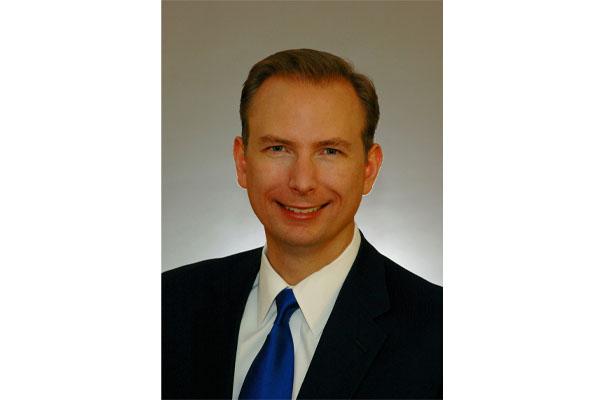
How a two-day simulation is preparing the next generation of national security professionals
Sitting around a large Mahogany block “O” shaped table, a handful of people type furiously away at their computers. Some are conversing in small groups, others flip quickly between a series of windows on their laptops before uploading a breaking news announcement that appears behind them on a large screen.
At the front of this ad hoc control room Mershon affiliate Dakota Rudesill, professor at The Ohio State University Moritz College of Law, stands at a small podium with his laptop in front of him. After a quick glance down at his notes, he turns his gaze to the rest of the room and casually asks the group, “Who wants to play the president of Russia?”
While the question may seem slightly odd, it fits neatly within the role playing capacity of The Ohio State University National Security Simulation, a two-day intensive exercise that gives students and faculty from Ohio State’s Moritz College of Law, John Glenn College of Public Affairs, Mershon Center for International Security Studies, and School of Communication, along with other graduate, military, and international studies students, the opportunity to experience what working in the national security field is like in the real world.
For some, including the students in Rudesill’s National Security Law and Process course, the simulation serves as the final exam, testing students on everything they’ve learned that semester and throughout law school. For others, it simply offers the chance to gain real world experience in the relative safety of an academic setting.
“Students learn best when they learn experientially, when they need to step into the shoes of people doing the jobs that they’ve been learning about in the classroom,” said Rudesill, who created the simulation. “We are providing an opportunity for them to do that and to do so working in concert with senior practitioners.”
Close to 100 students and nearly 50 professors and practitioners, including high-ranking retired members of the military, former federal and state legislators, federal judges, policy of officials, intelligence analysts, attorneys, reporters, alumni, and other Ohio State staff, immersed themselves for two days in an alternative world where their decisions determine the fate of the United States of America.
“I wish all young professionals before they go into government could have the benefit of this remarkable simulation Ohio State has built,” said former U.S. Sen. Kent Conrad after witnessing the simulation firsthand while playing the role of U.S. Senate majority leader in this year’s exercise. “You will not find a more intensive or realistic experience, short of doing the real thing.”
How the national security simulation came to be
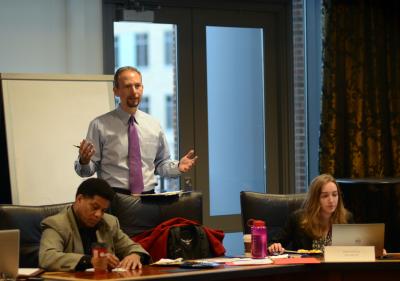
As a young professional on Capitol Hill, Rudesill quickly realized that while his education had provided him with a wealth of knowledge about the law, what it hadn’t given him was the professional training that could have benefitted him in the first few steps of his career. That experience would later inspire him as a law professor to find a way to provide his students with more practical training before they graduated, setting them up for success from day one.
“I think back to my own professional experience and reflect on the fact that so many times I wish the first time that I would have had to do something professionally challenging, such as brief a big personality on a complicated issue in two minutes, that I would have had the opportunity to practice doing that during my education and not have been doing that for the first time as an adviser to a U.S. senator,” Rudesill said. “All of us as professionals have those experiences, especially early in our careers, where we’re being challenged. What I’m trying to do with this simulation is provide an opportunity for students to have some of those very challenging professional experiences here in a relatively safe environment so they can make their rookie mistakes before they graduate.”
Rudesill’s first experience with running a simulated real world experience for lawyers came at Yale Law School, where he was asked to head a national security simulation for policy students under the school’s Grand Strategy Program. Later, as a visiting scholar at Georgetown University, Rudesill and two colleagues built a two-day simulation focused entirely on law in government. When he joined the faculty at Ohio State, Rudesill realized he had the opportunity to create a truly comprehensive program, thanks in part to the breadth of disciplines that call the university home.
“At Ohio State, we have the opportunity to leverage the fact that we are a major research university with so many different programs, which cover the full range of actors in government and national security decision making in particular,” Rudesill said. “Professionals from law, policy, military, intelligence, and communications, in all three branches of the federal government, plus state and local government, interact to produce decisions. Thanks to all that this amazing university offers, the Ohio State National Security Simulation is unique in the country in providing a full depiction of how national security decision making operates.”
Putting plans into action
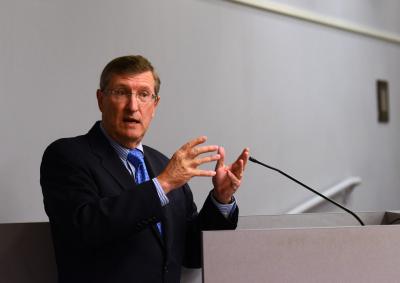
Rudesill may be the mastermind behind the project at Ohio State, but the simulation requires months of preparation by a whole team of people to come together. “There’s that phrase, it takes a village, and it certainly takes a village to put this together,” he said.
There are three main stages to planning and executing a successful national security simulation, Rudesill explained. The first step is to establish educational or pedagogical objectives. From there the team sorts out the logistics of such a large undertaking, which includes assessing question like: What facilities will they use? Where will they recruit their participants from? Where will the funding come from to cover food and VIP travel?
Once those questions are answered they can move onto the last but most enjoyable step of the planning process: crafting the story lines that will play out over the two-day simulation. The team starts by thinking about basic issues, decisions, and dilemmas they want participants to encounter as the exercise moves along. Then they formulate a more than 150-page, 6-column, 8-point-font document with hundreds of injects — planned media posts, intelligence updates, and in-person appearances — that students will have to process, analyze, and react to over the course of the two-day simulation.
With all the puzzle pieces firmly in place, the simulation begins. Students and players are assigned roles that coincide with their area of study or expertise in the executive, judicial, or legislative branches of the federal government, in state or local government, or in the press. Players from various disciplines staff each organization, just as it is in real life.
For example, within the Defense Department, the secretary of defense is played by a graduate student with a policy background; the chairman of the Joint Chiefs of Staff is played by a graduate student who is a veteran; the general counsel is played by a law student; and the director of the National Security Agency is a security and intelligence studies student. Keeping an eye on the public relations angle of the Pentagon’s work is a communications department student.
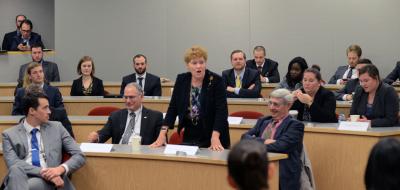
To get their issues on the agenda for the president, the Defense Department team works with the president’s national security advisor, Lala Qadir, a guest practitioner who in real life is a national security lawyer at Covington & Burling LLP in Washington. Working with her is another team of student law, policy, intelligence, and communications advisors in the simulation’s West Wing. Together, they run the multi-agency National Security Council.
Play starts with the world as it is that day. This allows the students to draw on everything they know about the real world. As time passes the control team begins driving the players toward particular dilemmas using the injects, forcing them to spot issues and use government processes to make hard decisions.
Like parts of a well-oiled machine, the members of the control team go back and forth, analyzing player decisions and deciding where to lead them next. Will they send them a helpful piece of information? Or will they push the envelope and send players down a more difficult path? Either way, play moves forward like a musical crescendo, the urgency of issues increasing with every passing moment, ending in one momentous plot twist that requires players to use their collective knowledge to consider the moral, ethical, and consequential outcomes of their final moves in the simulation.
The constantly changing nature of the exercise keeps both players and the control team on their toes. No one knows how the simulation will end — it’s all up to the decisions made by the players in real time.
“The number of injects at the start of the simulation is relatively heavy because we are starting to seed them with facts and inputs, which are going to tee-up these issues and decisions. As the simulation goes on, we use fewer and fewer pre-written injects, and more injects written on the spot, because at that point we’re responding to what the players are doing,” Rudesill explained.
In recent years, participants have been faced with fallout from a nuclear explosion, cyber attacks, and a widespread public health crisis. While the scenarios differ from year to year, students are always tasked with the same responsibilities: gather and analyze information on the issue, dissect its impact at the national and local levels, and advise senior leaders in the simulation on how they should proceed given the information at hand.
“The sheer size and scope of the simulation is just impressive,” said Trenton Weaver, an Ohio State graduate who came back to volunteer during the last simulation as general counsel to a U.S. senator. “It also struck me how everybody that was involved had their own motives in their individual roles, and yet, this machine still operated sort of like a ‘choose your own adventure.’ It could have gone many ways, but the whole simulation just went smoothly with all of these different personalities making decisions about how they were going to proceed.”
The art of a successful performance
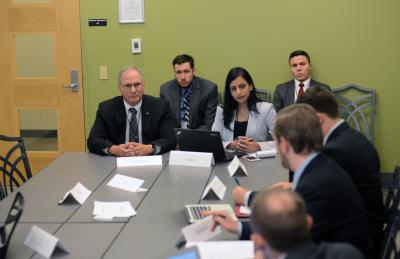
A large part of the Ohio State National Security Simulation’s success hangs on the role-playing abilities of its participants, from the real practitioners slipping into roles they may have or have not filled before and delivering an authentic performance, to the students taking on the obligations and responsibilities of real professionals. The more committed each person is to his or her specific role, the more realistic the simulation becomes.
One of the main lessons Rudesill said he hopes participants take away from this experience is the foundational skill of role assumption. “This means thinking about their professional identity — what is their job, what are its obligations, ethical commitments, and responsibilities. It also means thinking about what is not their role, and not trying to do someone else’s job.”
Practitioners who volunteer to play the most senior officials in the exercise are highly qualified people respected as experts in their fields. Involving such seasoned figures gives students the opportunity to not only build their confidence in interacting with big personalities, but to do so in a hard-hitting professional setting, teaching them the nuances of communicating with people at all levels of business and government.
Many volunteers come back again and again to resume their roles across multiple simulations. Many have said they enjoy having a hand in preparing the next generation of government and national security professionals to enter the profession.
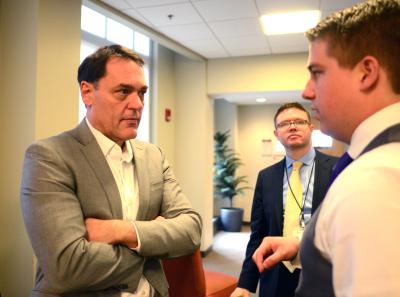
“Ohio State did a great job of pulling this together, and it was a terrific learning experience for all of the students involved,” said former U.S. Rep. Zack Space, who played a U.S. senator in the simulation. “The students were engaged, respectful, and a delight to be around. I would hire the student who advised me in a second. He conducted himself professionally, hit all the right notes, and performed at a very high level. What a rich and rewarding experience.”
Possibly one of the most memorable characters in the simulation over the last several years has been the president of the United States. Played by Peter Mansoor, Gen. Raymond E. Mason Jr. Chair of Military History at Ohio State, he challenges student participants to explain their reasoning for certain recommendations, asking hard hitting follow-up questions, and generally advancing the plot line through his actions and requests.
“As president you have to give guidance and energize the inter-agency team to produce policy to react to what’s going on in the world. It’s a very stressful time, given that Dakota has created a very challenging scenario, but it’s really great for the students to go through that,” Mansoor said.
When asked how he prepares to take on one of the leading roles in the simulation, Mansoor said he simply relies on his extensive knowledge of the national security field. In addition to being an Ohio State history professor, he commanded a U.S. Army brigade in Baghdad during the Iraq War and was a senior aide to Gen. David Petraeus, commander of Multi-National Force-Iraq. In this latter role, Mansoor was able to sit in on the margins of the weekly National Security Council meetings concerning the Iraq War, giving him an appreciation for the workings of government in crisis mode. As far as his mannerisms and the delivery of his speeches are concerned, Mansoor playfully said he takes his cues from reruns of television shows like The West Wing and House of Cards.
While he never envisioned himself becoming president, Mansoor said he has enjoyed his role, and feels the simulation is a true benefit to all of the students involved.
Students who have participated in the simulation report back that it was great professional training, whether they go on to national security work in Washington, or civil litigation in a small town. “I think that’s high praise for the way we prepare them to face issues that they might have to deal with in real life,” Mansoor said.
Why it matters
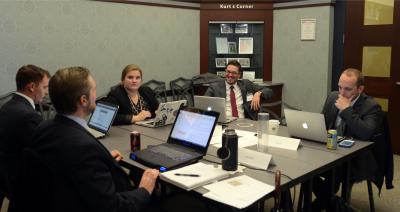
Both students and practitioners agree the Ohio State National Security Simulation provides invaluable experience for everyone involved. Like the real world, future lawyers and leaders have to interact and work together with people from many different backgrounds and skill sets.
“Participation in the sim builds two very important traits that I think are important to all lawyers,” said Christopher Ballard, who participated in the simulation as a student at Moritz and came back as a volunteer. “The first is being able to concisely brief non-lawyers on a legal issue. By bringing in practitioners of all different disciplines, Professor Rudesill created an environment where this is imperative. While it’s easy to talk to another lawyer at length about the nuances of a legal question, at the end of the day most of our clients will be non-lawyers needing condensed guidance. The second is building nerves. No matter our practice area, all lawyers are going to face tough ethical calls at one point or another in our career.”
Aside from the skill-building and networking aspects of the simulation, the exercise also highlights the magnitude of hard work that goes into crafting national security policy.
“Beyond the experience, what I hope everyone takes away is the sheer complexity of national security and what the government has to deal with,” Mansoor said. “This two-day scenario is just focused on national security; there aren’t any competing demands from domestic policy or politics or any of the other things that the president or the administration has to deal with on a daily basis. I think it’s a good model of just how complex our government is and the fact that we need good people in Washington to run it.”
Keynote Participants
U.S. Sen. Kent Conrad (D-ND, Ret.)
Chief Judge Colleen McMahon, U.S. District Court for the Southern District of New York
Other Practitioner Guests
Philip Axt, Yale Law School and veteran of U.S. Intelligence Community and U.S. Army
Ya’ara Barnoon, Associate, Hughes Hubbard & Reed LLP
Lt. Gen. Greg Biscone (USAF, Ret.)
Andy Chow, Reporter, WOSU Public Media
Bob Friedman, Manager, Radiation Safety, Battelle
Jo Ingles, Reporter, Ohio Public Radio and Television
Ben Johnson, Director of Media and Public Relations, Ohio State
Bob Kendrick, Anchor, ABC 6 News & Fox 28 News
Taylor Kline, Attorney Advisor, Office of General Counsel, U.S. Department of Homeland Security
Shaun Lyons, Associate, Carlile Patchen & Murphy LLP
Maj. Gen. Tim McMahon (USAF, Ret.)
Joe Meyer, Meyer Media LLC
William Moss, Attorney, Abercrombie & Fitch
Brian Perera, Assistant Vice President, Ohio State
Bill Pohlman, Pohlman Mediation Services LLC
Ben Presson, Battelle
Lala Qadir, Associate, Covington & Burling LLP
Justin Schardin, Director, Financial Regulatory Reform Initiative, Bipartisan Policy Center
Col. Rick Sinnreich (U.S. Army, Ret.)
U.S. Rep. Zack Space (D-OH, Ret.), Principal, Vorys Advisors LLC
Capt. Jon Spaner (USCG, Ret.), McKinsey & Associates
Lucas Sullivan, Reporter, The Columbus Dispatch
Col. Frank Titus (USAF, Ret.)
Travis Tritten, Reporter, Stars & Stripes
Mike Wagner, Reporter, The Columbus Dispatch
Ohio Sen. Mark Wagoner ’97 (R, Ret.), Partner, Shumaker, Loop & Kendrick LLP
Story by Kelsey Givens
Originally printed in All Rise, The Ohio State University Law School Magazine
